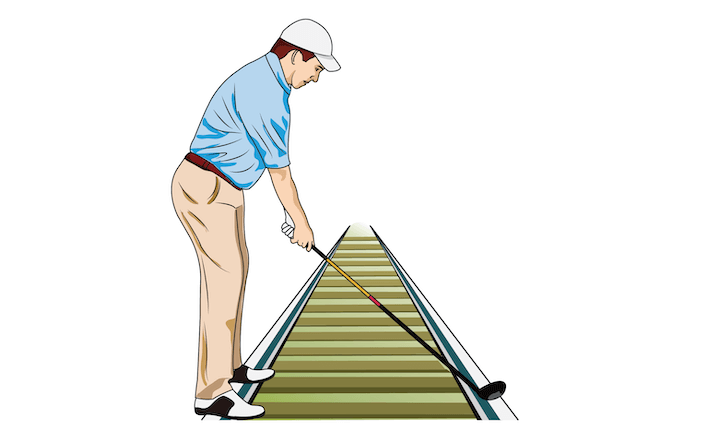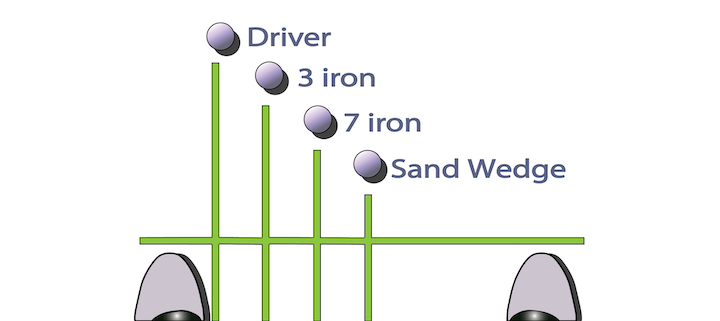The great teaching professional David Leadbetter once said:
“What invariably distinguishes a good player from a poor one is their respective address positions or setup.”
The implication from his quote is that, simply by perfecting the way you orient yourself at address (your golf stance), you can give yourself a big head start at hitting the ball better.
This should be good news for amateurs who are looking to improve their golf game.
Why?
Because regardless of your height, weight, strength, age, gender, or experience level, everyone can set up properly to the ball.
No special skills are required, and no golfer has an inherent advantage over another golfer in being able to set up correctly.
Man or woman, young or old, short or tall, stance is one part of the game at which you can excel.
In a sort of corollary to Leadbetter’s comment, Jack Nicklaus has said:
“If you set up correctly, there’s a good chance you’ll hit a reasonable shot. If you set up to the ball poorly, you’ll hit a lousy shot even if you make the greatest swing in the world.”
So, since a proper golf stance is such an essential part of making a good swing, and since everyone has the ability to implement these pre-swing fundamentals, all golfers should pledge to make sure that they try to perfect every element of the stance and setup basics.
4 Elements of a Good Golf Stance
There are several elements that comprise a proper golf stance:
- Posture
- Alignment
- Position of feet
- Ball position
Let’s take a look at each of these elements in turn, to understand what is required to have an ideal setup.
1. Posture
The first general piece of advice on posture would be to make sure that you’re in an “athletic” position.
In the same way that an athlete in any sport would prepare themselves for action by being in an active position, the golfer should also assume this kind of “ready” posture.
Start by slightly flexing your knees, so that your weight is over the balls of your feet. Bend from the hips -- not from the waist -- as you set your club down behind the ball.

The difference is subtle, but bending from the waist can cause the back to get rounded and it's tough to make a good swing from this unathletic position.
Another way to think of the proper spine position is to make sure that the angle of your spine is at a right angle to the shaft at address.
Done properly, your knees, the balls of your feet, and the middle of your upper spine would be in alignment, or “stacked.”
At the same time, make sure that your upper body is tilted slightly away from the target.
You’ll sometimes hear this referred to as a “Reverse K” position.
This is a crucial part of the stance to make a good golf swing, not just for the driver, but for your irons as well.
This will put you in a better position at the top of your backswing and will add stability to your swing as well.
It will also help you to get loaded onto your right side on the backswing, enabling you to shift your weight without sliding your hips.
2. Alignment
It’s hard to overstate the importance of good alignment in your setup.
Without proper alignment, your body will receive mixed signals from your brain.
When your eyes are looking at the target but your body and club face are actually aligned to the right or left of it, you’ll need to make adjustments in your swing.
This can result in any number of problems.
There is an image that is helpful for amateurs to visualize for correct alignment:

Think of yourself standing on the left side of some railroad tracks. The ball-target line is the track furthest away from you, while your feet are positioned along the track nearest to you. To make sure your alignment is correct, place your club down on the imaginary outside rail with the club face aimed straight down that track. Then align your body to be square to the clubface.
This is something you should work hard to get right.
It’s not uncommon for golfers to think they are aimed correctly, when in fact they are not.
There is often a big difference between where you are actually lined up and where you think you are lined up.
Here is a simple way to check if your feet are actually aimed down your target line:
- When you practice, as you prepare to hit a shot, place a golf club along the toe line of your feet.
- Then walk behind the ball to see if the club you had placed on the ground is really aligned parallel to the target line.
- If not, re-align your feet and check again.
- Keep doing this and soon your brain will be “re-trained” so that you will know in advance whether or not you are aimed correctly.
It’s important that, in addition to your feet, the rest of your body is also aligned with your feet and is parallel to the target line.
Knees, hips and shoulders should all be calibrated to make sure that they too are all in alignment.
3. Position of Feet
How you set your feet at address can have a direct and significant impact on the quality of your swing.
Let’s first discuss how wide apart your feet should be at address and then at how your feet should be angled.
a. Width of Stance
For a standard golf shot, the distance between your feet should match the width of your shoulders.
Specifically, the outside of your shoulders should line up with the middle of your feet.
There will be occasions when you will want to adopt a stance a little wider than this - e.g., when you are using a driver or other long club where you intend to make ‘fuller’ swing, or when you need to be more stable on a windy day.
And there will be times when you will opt for a little narrower golf stance such as when you are taking a smaller swing with a short iron.
But for normal, basic golf shots, the “shoulder width” standard should be used.
b. Feet Angle
This is an element of your stance that is often overlooked, but it shouldn’t be.
In the address position of many amateur golfers, the feet are set up with the toes aimed straight ahead, so that both feet are essentially perpendicular to the ball-target line.
This can be problematic, however, because feet that are set up in this manner can actually cause restricted movement in the rest of your body as you swing.
The recommended way to set your feet at address is to have both of them slightly flared out.
By flaring your feet slightly, you are enabling your hips and upper body to rotate more freely.
For example, if the foot on the trail leg (right leg for right-handers) is too “straight,” it will restrict your ability to rotate your hip and upper body behind you on the backswing.
And when your rotation is limited in this way, it can cause you to lift your arms prematurely or to raise up out of your posture.
Similarly, having the left foot too straight can have the same negative affect on your through-swing, by limiting your ability to properly rotate and turn through to your finish position.
4. Ball Position
Where you position the golf ball in your stance is another very important element that can affect how well you hit the ball.
Too many amateurs assume that the ball is to be placed in the same position relative to your feet regardless of the club they are using.
In fact, the position of the golf ball should change depending on the club that you’re using. The reason for this is that you want to slightly change the impact position and the launch conditions so that you get the best ball flight for each club.
So, for the shortest clubs in your bag -- lob wedge, sand wedge, gap wedge, pitching wedge, you should have the ball positioned in the center of your stance.

This enables you to have a little steeper attack angle and to create more backspin.
Then, for each longer club, the ball position should move slightly toward your front foot.
So a 7-iron, for example, would be played a couple of inches forward of center, toward your front foot.
The longest club in the bag, the driver, should be played just inside the front foot.
This ball position enables allows you to sweep the ball, or even to hit with an upward angle of attack, rather than hitting down on it as you want to do with short irons.
Summary
As mentioned at the outset, every golfer has the ability to build a perfect golf stance and setup position.
No special skills are needed to achieve that.
Why is it so important?
A good golf stance helps you achieve three things:
- You’ll be better able to maintain balance through the swing
- You can create more power and have better control of the direction of the shot
- You will increase the odds of making a fundamentally sound golf swing
